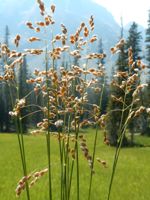Mon-Fri 9am - 5pm Mountain time
Sweetgrass vs Blue Flax
Anthoxanthum hirtum/Anthoxanthum nitens (Hierochloe odorata))
Linum lewisii
CUSTOM GROW
NOT AVAILABLE THIS SEASON - MIGHT RETURN
Sweetgrass is a cool-season perennial grass best known for its sweet, vanilla-like fragrance. The scent comes from coumarin in the leaves, which is pleasant to humans but has a bitter taste that makes the plant less appealing to deer and other herbivores. As a cool-season grass, Sweetgrass grows most vigorously in spring and fall, slowing or even going dormant during the heat of summer.
It spreads quickly through creeping rhizomes and can be difficult to remove once established, so it is best planted in areas where its spread will not cause problems. Due to its deep, vigorous root system and preference for moist soils, Sweetgrass is especially useful for erosion control, soil stabilization, riparian plantings, and naturalization projects.
Note: Sweetgrass was formerly classified under the scientific name Hierochloe odorata and its subspecies. The subspecies found in Canada are currently considered two distinct species: Anthoxanthum hirtum, which is native across Canada, and Anthoxanthum nitens, which is native to Eastern Canada. Because these two species are alike and share many overlapping common names, they are often considered as only one species.
Blue Flax is a native perennial wildflower known for its blue to violet flowers. Each flower lasts just a single day, but new blooms appear continuously, providing weeks of colour. This extended flowering period provides a reliable display from late spring into summer and attracts a variety of pollinators.
They can self-seed readily, so removing spent blooms helps manage their spread. Birds feed on the seeds, and when cooked, they are edible and are described as having a mild, nutty flavour. The plant grows in loose clumps with slender stems and fine foliage. Young plants are leafy, but as they mature, most leaves are shed.
Blue Flax grows well in a wide range of soils, including poor or sandy conditions, and is drought-tolerant once established. The deep root system helps to stabilize soil and prevent erosion. They are well-suited for pollinator gardens, restoration, naturalization, and xeriscaping projects.

